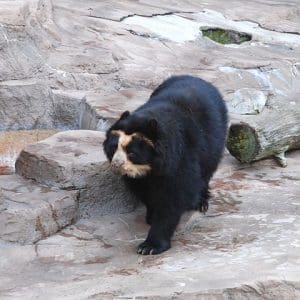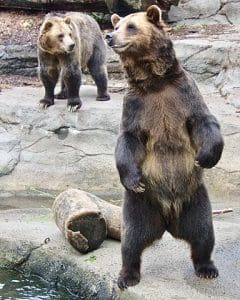In the depths of Virginia’s mountain forests, on the ice floes of Alaska, and in the northern wilds of Montana and Canada, forbidding giants roam. Despite sharing a similar body shape and some habits, bears come in a wide variety of sizes and eat many different types of foods. When you explore the wilderness, always beware of the bears and their savage temper. This article is a guide to the types of bears you can find across the Americas...and a few that vanished before our time. Prepare to enter the wild world of the bears of the Americas!
The Black Bear: Bear of Virginia and the East
There is only one type of bear native to Virginia and most of the East Coast. The American black bear can be found all over Virginia, although it is rarer on parts of the land close to the coast than it is in the forests or mountains. Even though they are often seen as predators, 80% of the calories black bears consume come from fruit, nuts, and other vegetables. They are considered omnivores as such and will eat a wide variety of food opportunistically. Black bear populations in Virginia fell drastically over the 19th century, so much so that the bears were almost extinct by the early 20th century. Over the last 70 years, the population has recovered to the point that roughly 18,000 bears are believed to live in Virginia now.
As the black bear population increases and as humans push into rural and forested areas, bear encounters have become more common in our area. Black bear sightings at Spotsylvania Courthouse and Fauquier County have attracted notoriety in the news and on social media. Bears that appear in suburban areas are typically young adults that have been evicted by their mothers after their second winter. Females mate every other year and must force their older cubs away so they may take care of newborn cubs. Black bears are a long-lived species, capable of surviving 18-23 years in the wilds of Virginia, and they have few enemies other than humans. Because of this, bears may be unusually brave for wild animals and come close to your house.
There are several steps you can take to avoid attracting bears. A black bear is most likely to be attracted by the smell of food, so don’t store your trash on a porch, deck, or vehicle. You can also use bear-resistant trash containers and take your trash to the dump frequently to avoid attracting bears to its scent. While camping, be sure to keep your campsite clean, sleep away from areas where you have cooked or stored food, and store your toiletries with your food. Black bear attacks on humans are extremely rare, but often begin as fights with a person’s pet dog or because the bear has smelled human food in the area. Even though black bears are not instinctive predators of humans, they will follow the scent of an easy meal, so make sure to reduce the smell of food around your home or campsite to avoid attracting them. Above all, do not feed any black bear cubs--this will set them up for a lifetime of raiding human garbage!
Giant of the Northwest: The Grizzly Bear
The other bear native to the lower 48 United States is considerably less common, but much more dangerous than the black bear. Grizzly bears, also called brown bears, only exist in a fraction of their former range and have been completely extirpated across most of the American Midwest and Mexico. They still live in Yellowstone National Park, parts of Wyoming and Idaho, northwestern Canada, and Alaska. Grizzlies are considerably larger than black bears; whereas most adult black bears are about 2-3.5 feet high at the shoulder on all fours, grizzlies are 3-5 feet high at the shoulder. Other than the size, other key means of identifying a grizzly include rounded ears, a large hump on the back, and a dish-shaped face profile.
Like black bears, grizzlies are omnivores, but their dietary mix has a few important differences. Depending on their location, grizzlies may eat meat much more frequently than black bears; grizzlies in Yellowstone National Park have a diet that is 51% meat-based, though grizzlies can eat as much, if not more, of a plant-based diet as black bears. Because their long, slightly curved claws allow them to dig for food more easily than black bears, grizzlies often dig for roots, shoots, and bulbs. Grizzlies can also use their digging skills to search for small mammals and shellfish. Grizzlies that live near the coasts and rivers in the Pacific Northwest also take advantage of salmon migrations to fatten up before they hibernate.
One more significant difference between grizzlies and black bears is their climbing abilities. Despite their considerable size, black bears are excellent climbers throughout their entire lives. They are just as likely to use their climbing skills to obtain food as to escape threats. Climbing can prove especially useful for black bears in places where their range overlaps with grizzlies. Young grizzlies can climb a tree just as well as black bears, but adult grizzlies can also climb if they need to. Their added bulk and the shape of their claws make it more difficult for them than for a black bear, but grizzlies can climb a tree if the branches are large enough for them to grab onto. Since this requires a specific type of tree with strong branches, adult grizzlies are less likely to climb than black bears, and grizzlies spend most of their time on the ground.
Master of the Frozen World: The Polar Bear

To the very far north, an even larger bear than the grizzly lives. Polar bears are the largest land carnivores that currently exist, but their range in North America is relatively limited. Polar bears are confined strictly to the Arctic Circle across the globe; their southernmost habitat is Newfoundland in Canada, and the only part of the U.S. they inhabit is the north of Alaska. All bears love water, but the polar bear is particularly at home in it; their bodies have a very thick layer of fat to insulate them from the frigid sea.
Polar bears live so far north that fruits and vegetables are extremely scarce, and they must obtain almost all their calories from meat. Climate change and the decline of sea ice in the Arctic have forced polar bears to be very flexible about their food. Some polar bears must swim for dozens of miles to find the sea ice for their favored hunting behavior. A polar bear’s favorite food is seals; they prefer the ringed seal and may also hunt for the bearded seal. Polar bears may target larger marine mammals such as walruses and even beluga whales, although successful kills of these are rare. With no hibernation period, polar bears must stay active and seek out food all year, and their curiosity sometimes leads them to trash dumps and abandoned human settlements in search of food and shelter.
As climate change begins to affect the polar regions, the lives of polar bears may change drastically. A recent study by York University in Ontario suggests that polar bears at the north of their range may be forced into isolation by melting sea ice and will rely heavily on beached whale carcasses to survive. Another recent study from Vanderbilt University suggests that polar bears to the south may be forced to eat hard foods, which their teeth aren’t designed for, and forced into competition with grizzlies. As a last resort for survival, polar bears may become more aggressive in competing for food on land and may flee parts of their Alaskan range for Russia. An animal designed for extreme cold facing a warming world, polar bears face an uncertain future.
Paddington’s Precursor: The Spectacled Bear

In the Andes Mountains of South America lives an unusual bear. The spectacled bear is a reclusive creature that prefers cloud forests and tends to eat a mostly plant-based diet. About 95 percent of the spectacled bear’s diet is fruits and vegetables. The spectacled bear is best known for its unique appearance, with a shorter snout than other bears and light brown markings on the face and upper chest that may resemble a mask or pair of glasses. Its charismatic appearance made the spectacled bear the model for Michael Bond's beloved character, Paddington Bear.
The spectacled bear’s unique appearance is because it is the last surviving member of the family of short-faced bears. This family once comprised many of the bears native to North and South America. Some of them, like the extinct Arctodus, grew to massive sizes, larger than even the polar bear of today. The short-faced bears are believed to have originated in the eastern United States and lived there until quite recently. Arctodus went extinct roughly 11,000 years ago; hunting by humans and competition with the grizzly (which arrived via land bridge from Asia) are possible causes. A species very similar to the spectacled bear, Tremarctos floridanus, once existed across much of the US. The “Florida spectacled bear” was about double the size of the current spectacled bear but is believed to have eaten a similar plant-based diet because of the shape of its teeth.
The spectacled bear is the most arboreal of bear species. Climbing is their preferred method of finding food, and they may even build platforms to rest on in the trees. The forests where they live offer enough food that they do not hibernate. Well adapted for their forest home, spectacled bears face daunting challenges in a time of deforestation and habitat fragmentation. They have been extirpated from Chile, where they were first identified by scientists, and have suffered severe population declines in Venezuela, Colombia, and Peru. The spectacled bear is a victim of persecution by farmers in some parts of its range, although this bear is very unlikely to attack cattle. Preservation of its habitat and educational campaigns will be needed to preserve this final short-faced bear, the last of its lineage.
Here are nonfiction titles for various ages about bears that can be found throughout the Americas.



